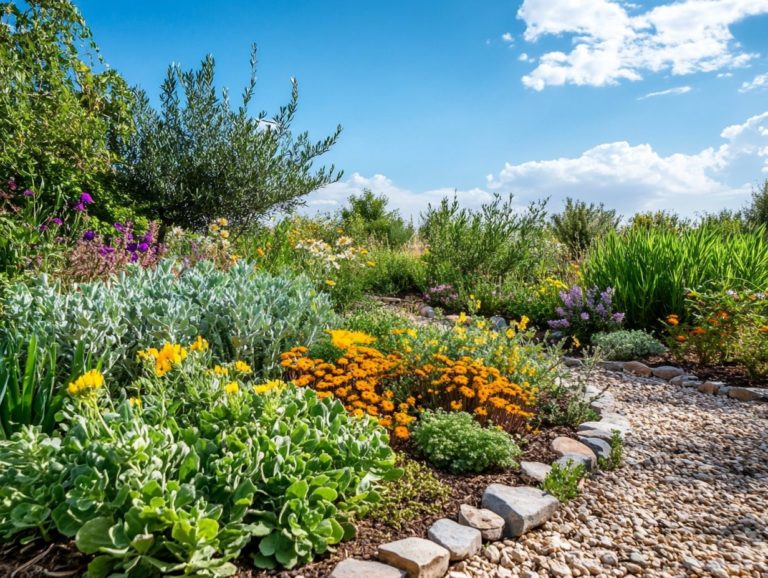The Role of Drought-Resistant Plants in Biodiversity
Biodiversity serves as the foundation of thriving ecosystems. Understanding its complex relationships is essential for the future of our planet, especially in the context of water scarcity and the role of drought-resistant native plants.
Plants hold a critical position in maintaining this balance. Drought-resistant native plants flourish in challenging climates, adapting to local conditions.
This article explores the importance of these resilient plants. We will showcase their unique traits, as well as their environmental and economic advantages, with examples that demonstrate their remarkable adaptability.
Get ready to learn how these plants support biodiversity and the ongoing conservation efforts aimed at safeguarding these invaluable resources for future generations. Working together can enhance community productivity.
Explore with us as we uncover the connection between drought-resistant plants and the vitality of our ecosystems, which significantly contribute to conserving water.
Contents
- Key Takeaways:
- The Importance of Biodiversity
- What are Drought-Resistant Plants?
- Benefits of Drought-Resistant Plants
- Examples of Drought-Resistant Plants
- How Drought-Resistant Plants Promote Biodiversity
- Conservation Efforts and Future Outlook
- Frequently Asked Questions
- How do drought-resistant plants help our ecosystems?
- How do drought-resistant plants contribute to biodiversity?
- Why are drought-resistant plants important for biodiversity conservation?
- Discover Amazing Drought-Resistant Plants
- How to Support Drought-Resistant Plants
- Unlocking the Benefits of Drought-Resistant Plants in Agriculture
Key Takeaways:

- Drought-resistant plants play a crucial role in preserving biodiversity by providing essential habitats and food sources for various species.
- These plants have unique adaptations that allow them to thrive in harsh and dry environments, making them valuable assets in combating climate change and promoting sustainable agriculture.
- Incorporating drought-resistant plants into conservation efforts can help protect and maintain ecosystems while providing economic benefits through reduced water usage and maintenance costs.
The Importance of Biodiversity
Biodiversity is essential for maintaining healthy ecosystems and supporting the complex relationships of life on our planet. It includes a variety of life forms plants, animals, and microorganisms that collectively bolster ecosystems’ resilience against shifting climates and extreme weather events.
When diverse species thrive, they enhance vital ecosystem services like water conservation and soil health. These services are pivotal in addressing challenges such as water scarcity. By understanding the significance of biodiversity and collaborating within your community, you can cultivate vibrant environments that attract wildlife and pave the way for a sustainable future.
Understanding the Role of Plants
Plants are essential players in ecosystems, acting as primary producers that create energy from sunlight. They offer food and shelter to countless wildlife, including pollinators and beneficial insects.
These remarkable organisms not only bolster biodiversity but also significantly enhance soil quality through their intricate root systems. These roots help prevent erosion and promote nutrient cycling, creating a healthier environment. They also provide crucial habitats for many species, offering refuge and resources that sustain various forms of life. By hosting numerous beneficial insects, plants facilitate vital ecosystem services, such as pollination, which is critical for the reproduction of many crops and wild plants alike.
In essence, the diverse contributions of plants to ecosystems highlight their critical role in maintaining ecological balance and supporting life on Earth.
What are Drought-Resistant Plants?
Drought-resistant plants are expertly crafted to endure and flourish in environments marked by water scarcity. They are essential for sustainable home gardening, especially in areas facing shifting climates and severe weather events.
Their ability to thrive under such conditions makes them a wise choice for any conscientious gardener looking to adapt to the challenges of a changing world.
Definition and Characteristics
Drought-resistant plants boast unique traits that empower you to conserve precious water and endure extended periods of dryness. With their deep roots, reduced leaf area, and clever adaptations to minimize water loss, these plants are nature s champions of survival in arid conditions.
These attributes enhance their resilience and make them exceptionally low-maintenance once established ideal for the busy gardener. Their robust nature allows them to flourish even in poor soil quality, positioning them as perfect candidates for sustainable gardening. Take hardy native perennials, for example; they are perfectly adapted to local climates and soils, reducing the need for extra resources like fertilizers and pesticides.
By integrating such resilient species into your garden, you can create a vibrant landscape while also contributing to environmental sustainability.
Benefits of Drought-Resistant Plants

Drought-resistant plants present numerous environmental and economic benefits worth considering. They play a crucial role in conserving water, reducing maintenance expenses, and fostering vibrant wildlife habitats that encourage diverse species interactions.
Embracing these resilient plants enhances the beauty of your surroundings and contributes to a sustainable ecosystem.
Environmental and Economic Advantages
Drought-resistant plants do so much more than just save water; they help our planet thrive! For instance, understanding drought resistance in plant species reveals how they preserve biodiversity and support wildlife by offering essential food and shelter.
Incorporating these resilient plants into your landscaping cuts down on irrigation demands while enhancing ecosystem management. Thriving in arid conditions, these plants significantly contribute to soil health, reduce erosion, and improve habitats for various species. Their ability to flourish with minimal resources alleviates the economic pressure on local water supplies, enabling communities to redirect those precious resources to other critical sectors like agriculture and tourism.
This symbiotic relationship cultivates a thriving ecosystem, ensuring wildlife flourishes while also delivering economic benefits through sustainable practices.
Examples of Drought-Resistant Plants
You ll find a remarkable array of drought-resistant native plants that are ideally suited to your local conditions. Consider popular options like Zigzag Goldenrod, Slender Mountain Mint, and Woodland Sunflower all excellent choices for attracting pollinators.
These plants not only thrive in challenging environments but also elevate the beauty and biodiversity of your garden.
Types and Adaptations
Drought-resistant plants showcase a fascinating array of adaptations that enable them to flourish in arid conditions. With specialized leaf structures, deep root systems, and efficient water storage capabilities, these plants are vital for maintaining soil quality and supporting local wildlife.
You may notice that many of these plants feature waxy surfaces or smaller leaves. Both of these adaptations serve to minimize water loss and help them endure extended dry spells. Some even employ unique modes of photosynthesis, a special way some plants save water during hot days.
The importance of these adaptations goes well beyond mere survival; they create invaluable habitats for pollinators and beneficial insects, offering essential resources such as nectar and shelter. This intricate web of life fosters biodiversity, helping to maintain ecological balance and ensuring that countless species thrive, including varied species interactions, even in the harshest environments.
How Drought-Resistant Plants Promote Biodiversity
Drought-resistant plants are essential in fostering biodiversity, as they play a crucial role in climate resilience. They enhance ecosystem services and provide critical resources for a myriad of species.
By doing so, they strengthen wildlife corridors and support a rich tapestry of species interactions, ensuring a thriving and resilient ecosystem.
Impact on Ecosystems and Habitats

Drought-resistant plants greatly affect ecosystems. They boost biodiversity and create sustainable environments that support many types of wildlife, including birds. Understanding why drought-resistant plants are essential today is crucial for promoting a healthy ecosystem.
These resilient species play a crucial role in soil health. They prevent erosion and improve nutrient retention, creating a strong foundation for diverse plants and animals.
They thrive in tough climates, offering habitats for pollinators, birds, and other creatures. Their ability to conserve water aligns with conservation efforts and helps balance human needs with environmental health.
Conservation Efforts and Future Outlook
Conservation efforts that promote drought-resistant plants are crucial to our future! As water scarcity and climate changes escalate, prioritizing these plants can help your community thrive.
Preserving Biodiversity through Drought-Resistant Plants
Cultivating drought-resistant plants helps create visually appealing gardens. These resilient ecosystems endure stress while supporting wildlife and people.
These plants require much less water, making them vital in the fight against scarcity. Local initiatives can empower you with knowledge about the benefits of planting native species, Drought Defenders, and low-maintenance plants.
By fostering collaboration, these initiatives enhance positive environmental impacts. Practices like conserving water also support biodiversity despite climate uncertainties.
Frequently Asked Questions
How do drought-resistant plants help our ecosystems?
Drought-resistant plants provide stability during dry spells. Understanding the role of drought-resistant plants in landscaping is vital, as they survive in harsh conditions, which is essential for maintaining biodiversity in drought-prone areas.
How do drought-resistant plants contribute to biodiversity?

They create diverse habitats and offer food and shelter for many organisms. Their survival boosts the ecosystem, maintaining a balance of wildlife, including birds, butterflies, and small mammals.
Why are drought-resistant plants important for biodiversity conservation?
Drought-resistant plants mitigate drought’s negative effects on ecosystems. By preserving these plants and understanding the benefits of drought-tolerant species, we support various species and enhance ecosystem health.
Discover Amazing Drought-Resistant Plants
Drought-resistant plants like cacti, Zigzag Goldenrod, Slender Mountain Mint, and Woodland Sunflower thrive in dry conditions. They provide essential resources such as food, water, and shelter for other species.
How to Support Drought-Resistant Plants
You can help these plants grow by using them in your garden. Consider gardens that benefit the environment, reduce water use, and avoid harmful pesticides.
Conservation efforts and restoration projects protect these plants in their natural habitats.
Unlocking the Benefits of Drought-Resistant Plants in Agriculture
Incorporating these plants into farming can lower water use and boost crop yields. This promotes healthy soil and creates a wildlife haven, providing habitat for animals.
These practices lead to sustainable farming that guards against the impacts of drought on food production. Act now to support these vital plants for a brighter, greener future!






